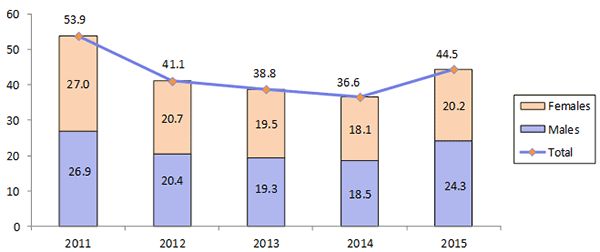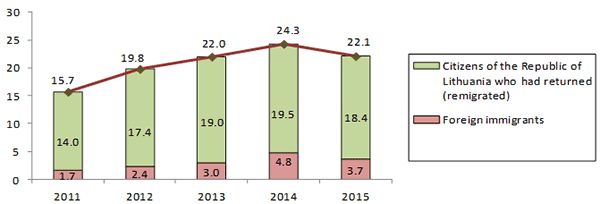Analytics, Baltic States – CIS, Demography, EU – Baltic States, Lithuania, Society
International Internet Magazine. Baltic States news & analytics
Tuesday, 23.04.2024, 15:47
In 2015, the negative international net migration in Lithuania stood at 22.4 thousand
 Print version
Print version
Last year, 22.1 thousand people immigrated to Lithuania, which is by 2.2 thousand (8.9%) less than in 2014. The number of immigrants per 1000 residents decreased from 8.3 (in 2014) to 7.6 (in 2015).
In 2015, 18.4 thousand (83.1% of the total number of immigrants) citizens of the Republic of Lithuania returned (remigrated) to Lithuania and 3.7 thousand (16.9%) foreigners immigrated to Lithuania; in 2014, 19.5 thousand (80.4%) and 4.8 thousand (19.6%) respectively.
Last year, the negative international net migration (the difference between the total number of immigrants and that of emigrants) stood at 22.4 thousand (in 2014, 12.3 thousand). In 2015, the negative international net migration per 1000 population stood at 7.7, in 2014 – 4.2.
In 2015, the number of male and female emigrants amounted to 24.3 thousand (54.6% of the total number of emigrants) and 20.2 thousand (45.4%) respectively, i.e. the number of male emigrants exceeded that of female emigrants by 4.1 thousand. Against 2014, the number of male emigrants increased 1.3 times, that of female emigrants – 11.7%.
 |
| Fig. 1. Emigrants by sex, 2011–2015, thousand |
In 2015, each third male emigrant was aged 19–26, each fifth – aged 27–34. Against 2014, the number of male emigrants aged 19–26 grew by 2.4 thousand, or 1.5 times, aged 27–34 – 810, or 1.2 times. In 2015, female emigrants aged 19–26 accounted for 28.5% of the total number of female emigrants, those aged 27–34 – 23.3%. Against 2014, the number of female emigrants aged 19–26 increased by 116 (2.1%), aged 27–34 – 577 (13.9%).
In 2015, most male and female emigrants aged 15 and older (81.7 and 85.6% respectively) had been unemployed for one year and longer prior to their departure (in 2014, 79.6 and 83.6% respectively).
In 2015, the number of emigrants who chose the United Kingdom as their destination of emigration amounted to 19 thousand (42.7%), Germany – 3.3 thousand (7.5%), Ireland – 3.2 thousand (7.1%), Norway – 2.9 thousand (6.4%), Russia – 2.8 thousand (6.3%), Ukraine – 1.8 thousand (4%). Against 2014, the number of emigrants to the United Kingdom increased by 2.2 thousand (13.3%), Germany – 412 (14.2%), Ireland – 93 (3%), Norway – 235 (8.9%), Russia – 1.5 thousand (2.2 times), Ukraine – 1 thousand (2.4 times).
Last year, 37 thousand (83% of the total number of emigrants) citizens of the Republic of Lithuania and 7.5 thousand (17%) foreigners emigrated from Lithuania; in 2014, 33.1 thousand (90.4%) and 3.5 thousand (9.6%) respectively.
In 2015, one-third (30.3%) of foreign emigrants were the citizens of the Russian Federation, a quarter (22.4%) – the citizens of Ukraine, one-fifth (20.1%) – the citizens of Belarus.
Most – 75.9% – emigrants had been born in Lithuania, 6.4% – in Russia, 4.1% – in Ukraine, 3.6% – in Belarus, 2.5% – in the United Kingdom.
In 2015, more than half of male and female emigrants aged 18 and older (63.1 and 53.3% respectively) had never been married (in 2014, 58.7 and 54% respectively). In 2015, each fourth male and each third female emigrant aged 18 and older was married; in 2014, each third and each fourth respectively. Male and female emigrants aged 18 and older who were divorced and widowed accounted for 9.2 and 17.3% respectively (in 2014, 11.3 and 18% respectively).
In 2015, most Lithuanian nationals who returned (remigrated) to Lithuania came back from the United Kingdom (8.7 thousand, or 47.4% of the total number of Lithuanian nationals who returned (remigrated) to Lithuania), Norway and Ireland (2 thousand, or 11%, from each), Germany (1 thousand, or 5.5%), Spain (586, or 3.2%). In 2014, each second Lithuanian national who returned (remigrated) to Lithuania came from the United Kingdom, each ninth – Ireland, each tenth – Norway.
In 2015, 1.1 thousand (30.7% of the total number of foreigners) foreign immigrants to Lithuania were the citizens of Ukraine, 696 (18.6%) – the Russian Federation, 387 (10.3%) – Belarus. Against 2014, the number of the citizens of Ukraine who immigrated to Lithuania remained almost unchanged, the Russian Federation and Belarus – decreased 2 and 1.3 times respectively.
 |
| Fig. 2. Immigrants, 2011–2015, thousand |
Over the last two years (2014–2015), each fourth citizen of the Republic of Lithuania who had returned (remigrated) to Lithuania was aged 25–29, every sixth – aged 30–34, every seventh – aged 20–24.
In 2015, persons aged 30–34 accounted for 14.8% of the total number of foreign immigrants, those aged 25–29 – 14.5%, those aged 35–39 – 12.2% (in 2014, 15.7, 12.8 and 15% respectively).
Concepts
Emigration is the departure from a country with the intention to take up permanent residence in another country or for a period longer than 12 months.
Immigration is the arrival in a country with the intention to take up permanent residence or for a period longer than 12 months.
Net international migration is the difference between the total number of immigrants and that of emigrants.
Foreigner is any person other than a citizen of the Republic of Lithuania, irrespective of whether s/he is a foreign national or a stateless person.
More information on the issue is available in the Database of Indicators.








 «The Baltic Course» Is Sold and Stays in Business!
«The Baltic Course» Is Sold and Stays in Business!

